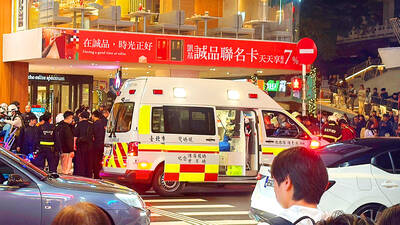Taiwan is considering setting up renewable power plants in neighboring countries, such as the Philippines, and transporting the electricity back home to meet the green power needs of Taiwanese manufacturers, Minister of Economic Affairs J.W. Kuo (郭智輝) said yesterday.
“The green power could be brought back via ships or submarine cables,” the Chinese-language Liberty Times (the Taipei Times’ sister newspaper) quoted Kuo as saying on the sidelines of the annual Taipei Innovative Textile Application Show at the Taipei Nangang Exhibition Center.
As local governments and residents frequently differ in opinion about constructing new power plants, and it takes time to communicate and bridge the differences, the Ministry of Economic Affairs has to find a way to meet the nation’s industrial development and carbon reduction goals, as manufacturers needing green power cannot afford to wait, Kuo said.

Photo: CNA
While deliberations on this idea are still in the early stage, Kuo touted the substantial benefits of building renewable power plants abroad.
First, it would address the problem of setting up new power plants in Taiwan, and second, the imported green power would be cheaper than renewable energy developed in Taiwan, he said.
As Taiwan is in the process of shutting down its nuclear power plants and the government has pledged to cut carbon emissions and achieve net zero by 2050, the nation’s demand for green energy would only grow, he said.
Kuo added that the idea of building power plants abroad was inspired by Singapore, which plans to import power from Australia, which is about 4,800km away.
It should therefore not be a problem for Taiwan to establish a green power plant on the Philippine island of Luzon, which is about 300km away, he said.
There are three types of green power that can be developed in the Philippines: solar, wind and geothermal, he said.
“We will look for a neighboring country that offers resources where we can develop green power, and we will encourage Taiwanese firms, not necessarily state-run Taiwan Power Co (台電), to build the power plants there,” before bringing the energy back to Taiwan, Kuo said.
The minister added that American Institute in Taiwan Director Raymond Greene would assist Taiwan in finding suitable locations for overseas power plants, including the Philippines and Japan.
Kuo first shed light on building renewable power plants in the Philippines on Monday night when he attended the launch of the Indo-Pacific Strategic Thinktank in Taipei.
He added that Taiwan hopes to contribute to the Luzon Economic Corridor launched by the US, Japan and the Philippines earlier this year to boost regional development.
However, experts said that building a submarine cable between Taiwan and the Philippines could present challenges, including time and cost.

TRAGEDY STRIKES TAIPEI: The suspect died after falling off a building after he threw smoke grenades into Taipei Main Station and went on a killing spree in Zhongshan A 27-year-old suspect allegedly threw smoke grenades in Taipei Main Station and then proceeded to Zhongshan MRT Station in a random killing spree that resulted in the death of the suspect and two other civilians, and seven injured, including one in critical condition, as of press time last night. The suspect, identified as a man surnamed Chang Wen (張文), allegedly began the attack at Taipei Main Station, the Taipei Fire Department said, adding that it received a report at 5:24pm that smoke grenades had been thrown in the station. One man in his 50s was rushed to hospital after a cardiac arrest

A car bomb killed a senior Russian general in southern Moscow yesterday morning, the latest high-profile army figure to be blown up in a blast that came just hours after Russian and Ukrainian delegates held separate talks in Miami on a plan to end the war. Kyiv has not commented on the incident, but Russian investigators said they were probing whether the blast was “linked” to “Ukrainian special forces.” The attack was similar to other assassinations of generals and pro-war figures that have either been claimed, or are widely believed to have been orchestrated, by Ukraine. Russian Lieutenant General Fanil Sarvarov, 56, head

SAFETY FIRST: Double the number of police were deployed at the Taipei Marathon, while other cities released plans to bolster public event safety Authorities across Taiwan have stepped up security measures ahead of Christmas and New Year events, following a knife and smoke bomb attack in Taipei on Friday that left four people dead and 11 injured. In a bid to prevent potential copycat incidents, police deployments have been expanded for large gatherings, transport hubs, and other crowded public spaces, according to official statements from police and city authorities. Taipei Mayor Chiang Wan-an (蔣萬安) said the city has “comprehensively raised security readiness” in crowded areas, increased police deployments with armed officers, and intensified patrols during weekends and nighttime hours. For large-scale events, security checkpoints and explosives

PUBLIC SAFETY: The premier said that security would be tightened in transport hubs, while President Lai commended the public for their bravery The government is to deploy more police, including rapid response units, in crowded public areas to ensure a swift response to any threats, President William Lai (賴清德) said yesterday after a knife attack killed three people and injured 11 in Taipei the previous day. Lai made the remarks following a briefing by the National Police Agency on the progress of the investigation, saying that the attack underscored the importance of cooperation in public security between the central and local governments. The attack unfolded in the early evening on Friday around Taipei Main Station’s M7 exit and later near the Taipei MRT’s Zhongshan